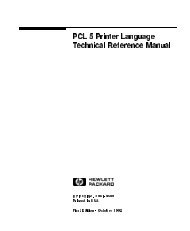The Orbix Architecture - Distributed Object Computing (DOC) group
The Orbix Architecture - Distributed Object Computing (DOC) group
The Orbix Architecture - Distributed Object Computing (DOC) group
You also want an ePaper? Increase the reach of your titles
YUMPU automatically turns print PDFs into web optimized ePapers that Google loves.
then the server by default will also be called bank. However it is quite common for the sameserver to implement several IDL interfaces: our bank server might also contain code toimplement IDL interfaces for bank account objects, bank statements, the bank manager,and so on. In this case, it may be possible to choose the server name by identifying a masterinterface which abstracts the functionality which the entire server provides, and via which allobjects managed by the server are obtained. For a banking application, the interface to thebank itself may be such a master interface.Finally, a server name can be chosen which is independent of any particular IDL interface.For example, we could choose financialRepository as the name of our bank server,even though there is no IDL interface with that name in the application. Server names canalso be hierarchically structured, similar to UNIX file names.<strong>The</strong> name chosen for a server is significant because it is registered in the ImplementationRepository, and used by orbixd to identify the executable file which should be used toactivate the server. <strong>The</strong> same executable file can be registered under several server names;i.e. different servers can use the same executable image.When a client program wishes to use a particular named service at runtime, it must instruct<strong>Orbix</strong> to bind the client to a suitable server. One way to do this is for the client to provide<strong>Orbix</strong> with a character string which represents a full <strong>Orbix</strong> object reference: this mechanism isprescribed by the CORBA specification. <strong>The</strong> source of such a character string is notprescribed: it could be found in a file, or indeed transcribed from an electronic mail or faxmessage!Alternatively, in <strong>Orbix</strong>, a client can bind to a specific server name at a particular host. <strong>The</strong>server name must be one of the server names registered in the Implementation Repository atthat host - for example, bank or financialRepository as above. <strong>The</strong> client can gofurther, and attempt to bind to a specific named object at that server, as given by the object'smarker name. If the client does not specify a target marker name, then <strong>Orbix</strong> binds the clientto any object within the server which provides an interface compatible with that expected bythe server.<strong>The</strong> most general form of a client bind is when the client identifies a service, but not a specifichost which can provide that service. <strong>The</strong> service is named by a server name: zero or morehosts 4 may recognise that server name, based on the information in their respectiveImplementation Repositories. In this case <strong>Orbix</strong> must "search" the network, looking forsuitable hosts.Such a search is managed by the location mechanism, implemented in the <strong>Orbix</strong> runtime bythe abstract class locatorClass. This class is called with a service name (as a characterstring) and is expected to return a list of host names at which the service appears to bepresent. <strong>The</strong> locatorClass is usually used transparently to application code.<strong>The</strong> default implementation of locatorClass uses a configuration file at each host: thisregisters knowledge about which hosts, and <strong>group</strong>s of hosts, can provide specific services.Each configuration file can contain a pointer to another host to which queries can be4 In fact, the orbixd daemons running at those hosts.info@iona.ie Page 13









